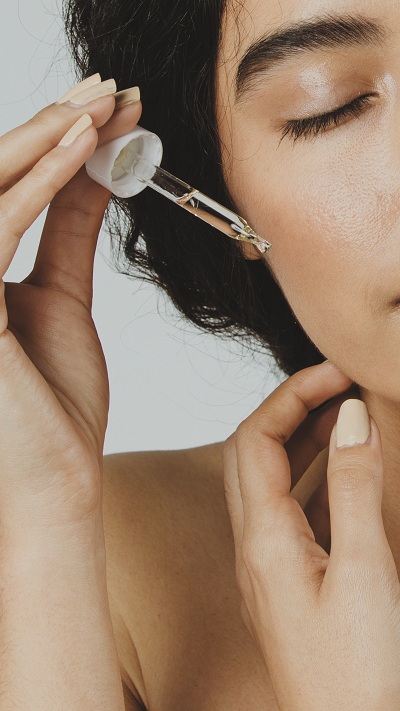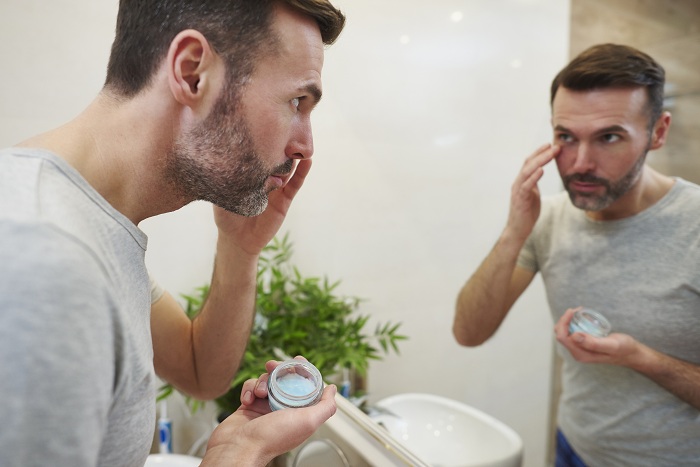Dry skin is one of the trickiest skin types to care for – get things wrong and you’ll experience dry patches, flakiness, and an uncomfortably tight sensation in your skin.
However, put together a skincare routine that’s tailored towards healing and hydrating dry, delicate skin and your complexion should soon take on a smoother and softer finish.
A Daily Skincare Routine for Dry Skin
The skin care routine that we’ve laid out below has been designed for those with a dry skin type. Ideally, you should be following this routine twice a day; once in the morning, and then once again at night.
Start with a Gentle, Cleanser

Every complete skincare routine should begin with a cleanser. However, this is where people start to go wrong – many of the cleansers out there contain ingredients that strip the skin’s lipid barrier of its natural oils.
This barrier is responsible for retaining natural moisture, meaning that any damage it experiences will lead to your skin drying out faster than ever.
When choosing a face wash for dry skin, look for a hydrating cleanser. Milky and creamy formulas are the least disruptive, whereas foaming cleansers tend to cause the most damage – these are best suited to those with acne-prone skin.
Follow Up with a pH-Balancing Toner
Even the most gentle cleanser formulas out there will still likely interfere with your skin’s natural pH balance, which is why following up with a pH-balancing toner is extremely important.
Not only will this remove any leftover makeup and cleanser residue, but it’ll also rebalance your skin. This will help to strengthen and support your skin’s protective barrier, encouraging it to retain moisture more efficiently.
Apply a Vitamin C Serum

No matter your skin type, just about every board-certified dermatologist out there would recommend adding vitamin C to your skin routine.
Why? Because this powerful antioxidant is a mega multi-tasker:
- It keeps the skin hydrated by preventing transepidermal water loss [1] (the rate at which moisture evaporates out of your skin)
- It accelerates collagen production to reduce the appearance of fine lines and wrinkles, making it a popular anti-aging ingredient
- Its brightening effects help to fade dark spots and even out the skin tone
- Its antioxidant properties help to repair sun-damaged skin
Now, as great as vitamin C may be, it’s worth noting that it can also be quite an irritating ingredient.
There are several different forms of the vitamin out there, with sodium ascorbyl phosphate being the most suitable for dry skin. It’s gentle yet effective, so long as you use it regularly.
Soothe Skin with a Hyaluronic Acid Serum
Once you’re done infusing your skin with antioxidants, it’s time to soothe dry skin with hyaluronic acid. This ingredient has been everywhere lately – it’s one of the most hydrating ingredients in the industry.
Hyaluronic acid works as a humectant. It draws moisture from the environment and sends it deep into the skin, which is why skin cells take on a plumper and fuller appearance after hyaluronic acid has been applied.
A hydrating serum containing hyaluronic acid is a great way to combat peeling and flaky skin – it’ll leave your complexion with a much smoother and softer finish.
Dab on an Eye Cream
The skin around the eyes is much thinner and more fragile than the skin on the rest of the face. So, for the very best skincare routine, you’ll need to include an eye cream.
Again, look for active ingredients that’ll add moisture while also protecting your skin. Humectants are a must, while peptides and ceramides can also work wonders on dry skin.
When applying an eye cream, be gentle. Experts recommend using your ring finger to apply the product, since this finger exerts the least amount of pressure. Tapping the product into your skin, rather than rubbing it in, can also help to increase absorption.

Moisturize
If you want to keep your skin healthy, a hydrating moisturizer is a must. Those with dry skin usually need thicker and greasier formulas than those with other skin types, especially during the colder months of the year.
If you’re following this routine during the day, then look for protective hydrating ingredients, such as sodium hyaluronate, glycerin, and vitamin E.
Alternatively, if you’re following this skin care routine in the evening, look for a night cream that’s packed with plant oils and butters. These will deliver a hefty dose of antioxidants to your skin that will help to repair environmental damage.
Whether you’re applying a day cream or a night cream, try to moisturize while your skin is still damp. This will help to seal in all of those existing water molecules that are already sitting on your skin, rather than leaving them to evaporate away, which gives the skin a double dose of moisture.
Layer on Some Sun Protection
You can skip this step at night, but sun protection is absolutely vital during the day. The sun’s UV rays cause some serious damage to the skin. They destroy protein fibers, interfere with skin cell DNA, and can even lead to skin cancer.
It’s worth noting that while physical/mineral sunscreens are best used after a moisturizer, applying sunscreen with chemical blockers should be done before. This ensures that your skin can fully absorb the chemicals that’ll protect it from UV rays, without your moisturizer blocking the way.
Weekly Additions to Your Skin Care Routine
The above skin care routine for dry skin should be followed daily. However, there are a couple of extra steps that you should be adding in once or twice a week to really give your skin a boost.

Exfoliate Dead Skin Cells
Exfoliation is an important part of every skin care routine, especially as you age. Exfoliating skincare products clear away the dead skin cells, excess sebum, and dirt that settles into your pores.
This not only gives you a clearer and fresher appearance, but will also prevent clogged pores and acne breakouts.
Exfoliants usually fall into two categories; physical and chemical. Most people start with physical exfoliants, such as scrubs, because they’re widely available and easy to use.
However, chemical exfoliants are actually much gentler, since they don’t require you to pull and tug at your skin.
That said, the ingredients used in chemical exfoliants vary in potency. Since dry skin is quite delicate, look for one containing lactic acid. This alpha hydroxy acid is gentle, but will also help to add moisture back into your skin, making it suitable for sensitive skin too.
One final exfoliating tip: don’t overdo it! Over-exfoliation is a very real problem. It’ll damage your skin’s protective barrier even more, leaving you noticeably drier than you were. Those with dry skin only need to be exfoliating once or twice a week.
Indulge with a Face Mask
So many people neglect to include face masks in their skin care routine, but they really are so beneficial at giving the skin a deep dose of nutrients.
There are so many different types of face masks out there, but, as always, you need to go for hydrating formulas. Sheet, gel, and cream masks tend to be best for this.
Stay away from clay masks – they’re known for being quite drying, especially if you leave them on your skin for too long.
FAQs

How do I start a skin care routine for dry skin?
A skin care routine for dry skin should always start with a cleanser and a toner.
What do dermatologists recommend for dry skin?
Dermatologists recommend hydrating and moisturizing ingredients for dry skin, such as hyaluronic acid and ceramides.
They also advise on making certain lifestyle changes to help increase skin moisture levels, such as drinking more water and sleeping with a humidifier on.
Summary
Dry skin may seem difficult to care for, but put the effort in now and you won’t have to deal with the dryness forever. Skin types aren’t set in stone – they actually vary depending on the season, your age, and your lifestyle.
So, even though your skin may currently be on the drier side, focus on hydrating it as much as possible through your skincare routine and you should see an improvement in no time!
References
[1] https://www.ncbi.nlm.nih.gov/pmc/articles/PMC3673383/